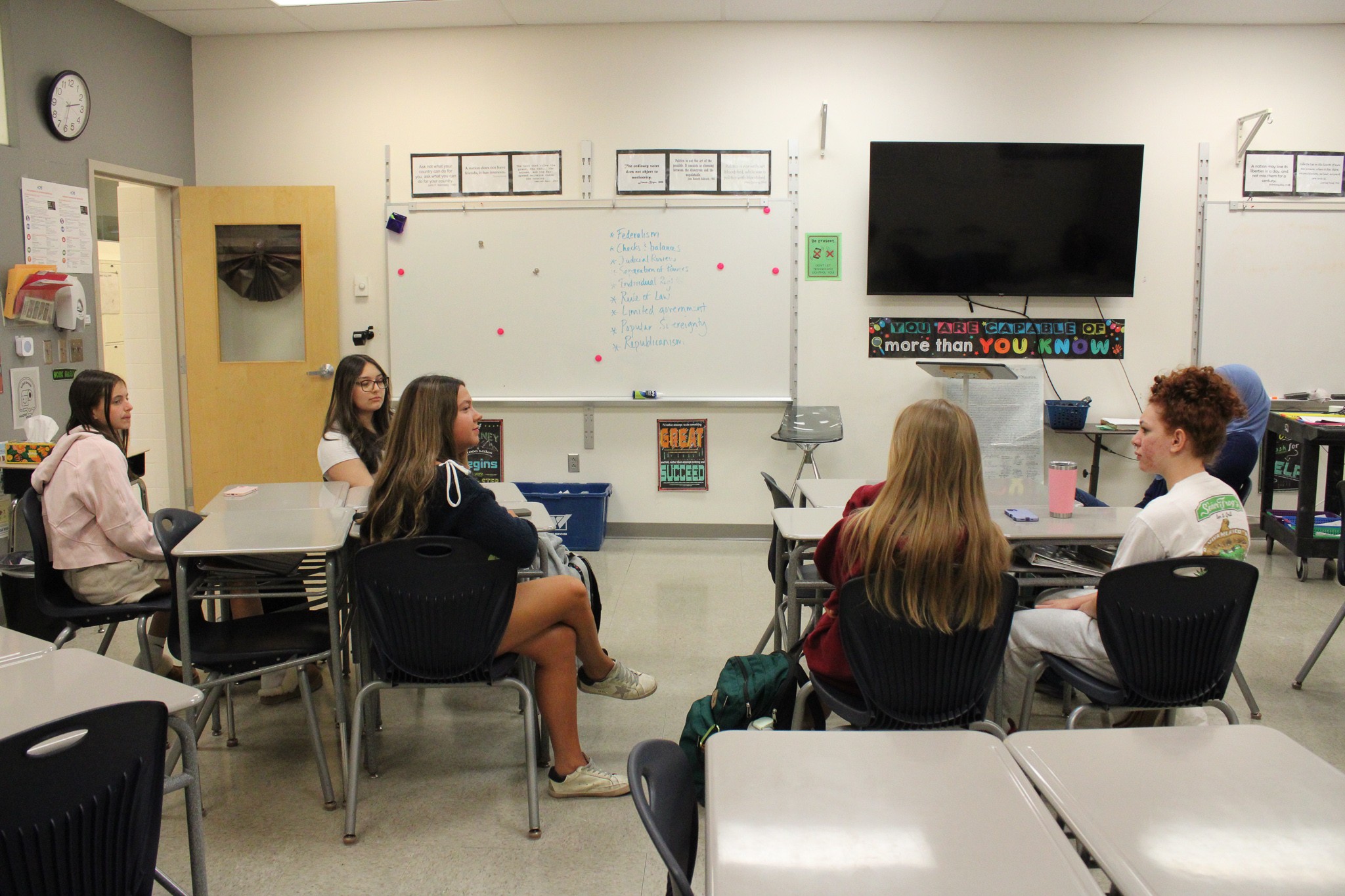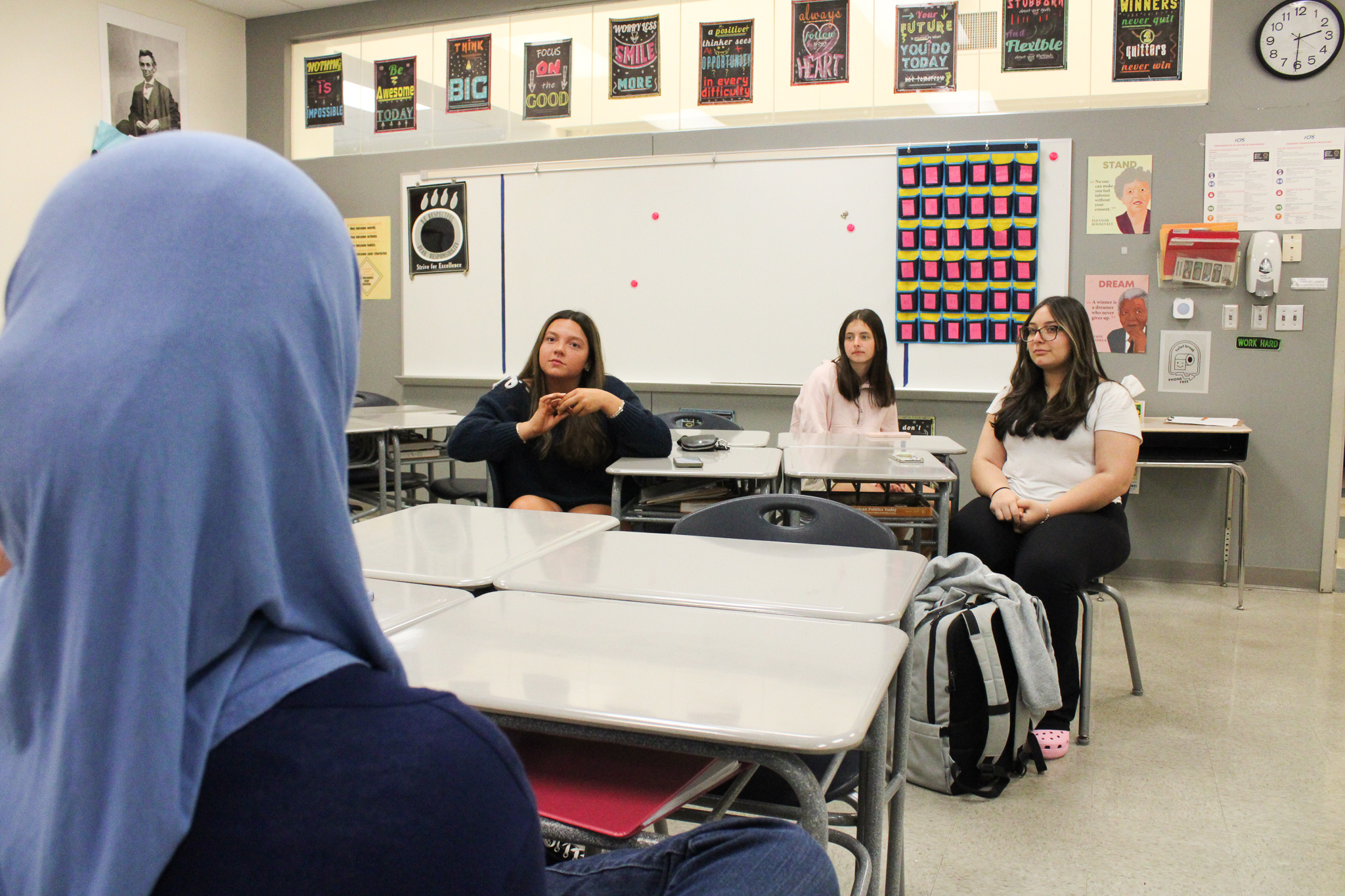IJAMSVILLE, Md. — One day before prom, in an advanced placement government classroom at Oakdale High School southeast of Frederick, Maryland, a group of students gathered to film the school’s morning announcement.
“Students Against Violence Everywhere, also known as SAVE, has decided to highlight our trusted adults, and we want you to vote to showcase our positive school climate and show appreciation for our teachers,” said Evie Graham, president of SAVE at Oakdale.
And while it might not be obvious, that announcement was part of a student-led effort to prevent the worst from happening at Oakdale High School.
During her freshman year at Oakdale, Graham became a “promise leader” with the Sandy Hook Promise, a nonprofit founded by several family members of the victims of the Sandy Hook Elementary School shooting in Connecticut, which claimed 26 lives in December 2012.
Through Sandy Hook Promise, Graham learned how young people can engage and teach others about preventing gun violence. Soon, she founded a SAVE club at her school.
“The second I saw that [there was a club], I kind of knew that I wanted to start one here,” said Graham, now a senior at Oakdale. “I like putting action behind my words. I, like, vividly remember when I was a sophomore [or] freshman, and I would see, every single day, a new headline come across my phone [about gun violence]. I would get so frustrated.”
The Sandy Hook Promise mission is to “educate and empower youth and adults to prevent violence in schools, homes and communities,” according to its website. Founded in 2013, it’s an organization that draws praise from those who have studied its work — even though researchers find it difficult to prove that any one effort could curb school violence.
“It’s, I think, important that schools, as they’re adapting programs like this, where you’re trying to get to create connections, that people are comfortable speaking up — that you can demonstrate to students that their concerns are going to be heard, that they’re going to be validated,” said Justin Heinze, an associate professor of health behavior and health equity at the University of Michigan who has studied Sandy Hook Promise and its effectiveness.
Addressing a need
Sandy Hook Promise aims to address a dire problem. Johns Hopkins Bloomberg School of Public Health found that from 2013 to 2022, the gun death rate among children ages 1-17 increased by 106%, with firearms becoming the leading cause of death for youths.
In response to the growing concern over school violence, David Riedman, an assistant professor at the Department of Homeland Security and Emergency Services at Idaho State University, created the K-12 School Shooting Database. According to the database, there were 2,983 incidents of school shootings from 1966 to 2024, with the number of incidents increasing dramatically over the past six years, peaking at 349 in 2023.
To counter those trends, Sandy Hook Promise created an anonymous reporting system and three prevention programs: Start with Hello, Say Something and the SAVE Promise Club, which has over 5,000 registered clubs across the United States, including the one at Oakdale High School.
Start With Hello is a training program for K-12 students that helps reduce social isolation, build empathy and create a more inclusive school community. Say Something, also for K-12 students, teaches them to recognize warning signs that someone may be in crisis and to seek help from a trusted adult.
Officials at Sandy Hook Promise declined several interview requests, but on the group’s website, its co-founder and co-CEO, Mark Barden, outlined its mission.
“We are proud to work with the bipartisan champions to ensure we’re doing everything we can to protect our kids and that millions more students will be trained to know the signs of violence and act to save lives,” Barden said.
Taking action
Graham reached out to Oakdale High School principal Bill Caulfield when she decided she wanted to create the SAVE Club in May 2023. She quickly drew in other students — mostly girls — and support from teachers.
“[This club] gives voice at the local level to a national issue, it gives an outlet for students,” said Elisabeth Smith, the club’s advisor and a social studies teacher at Oakdale High School. “A lot of students don’t know how to affect change at a national level, much less a local level. So this is just kind of an opportunity of grassroots-level organizing in order to change the way schools exist.”
Liliana Meertens, a senior at Oakdale High School, said she joined the club because she knew Graham and shared a similar commitment to preventing gun violence and promoting mental health awareness.
“This [club] is going to be something where I feel like we can get something done,” Meertens said.
By Aug. 30, 2023, the school’s SAVE Promise Club was established and registered with Sandy Hook Promise. Since its creation, the students have run multiple advocacy campaigns in their school, including putting up boards around the school and recording morning announcements.
Last year, Emily Lockard managed the club’s Instagram account and, along with fellow members, promoted Sandy Hook Promise’s “14 Days of Action” initiative and its overall mission — to spread positivity and prevent violence in school.
During the club’s first meeting in 2023, 38 students wrote letters to trusted adults in their lives.
These letters, dedicated to teachers, coaches, community leaders, church leaders and family members, showed them that students felt comfortable with them and appreciated the positive, welcoming environment they created.
View this profile on Instagram
One event Graham is most proud of is “Get To Know Your SRO,” where Graham and fellow members of SAVE interviewed their school resource officers. They then posted a series of videos on Instagram to allow students to “peel back the layers” and understand that these in-school officers are not just authority figures.
The SAVE club’s work resonates with students such as Ariana Juarez, a freshman at Oakdale.
“It honestly just gave me more reassurance that there was a club like this because that was something that I was concerned about, and I’m just glad that there’s an ability to, you know, advocate for it and just bring more peace into our schools,” she said.
Emerging from a nightmare
Despite the club’s work on campus, the students understand that creating real, lasting change goes beyond school walls. Their efforts are part of a much larger conversation about how to prevent gun violence at its roots.
Advocates push for measures addressing both the availability of firearms and a lack of investment in prevention efforts amid a nationwide shortage of mental health professionals.
“There’s been multiple strategies that have emerged from the nightmare in Sandy Hook,” said Woodie Kessel, a professor of the practice in family science at the University of Maryland School of Public Health. “But it goes back again to the availability of weapons and just not investing in the primary and secondary prevention of this effort. We still seem to worship gun ownership in this country, despite the fact that it’s the root cause of so much sadness and trauma.”
Prevent Gun Violence: Research, Empowerment, Strategies & Solutions — also known as PROGRESS — is an initiative at the University of Maryland that focuses on gun violence prevention through research and community engagement. Kessel and Joseph Richardson Jr., a professor of African-American studies at the university, co-direct the initiative.
And while they support the Sandy Hook Promise mission, Kessel and Richardson are not entirely sold on its effectiveness.
“The programs are still being evaluated, so there aren’t any conclusive findings yet in terms of the outcomes and whether the outcomes are actually effective in terms of the design models that they’ve created,” Richardson said. “They haven’t produced any findings yet.”
Heinze said it is difficult to say how programs implemented by the Sandy Hook Promise are actually preventing or reducing active shooter incidents because it’s impossible to measure what hasn’t happened. But he supports the group’s mission.
“It’s actually a positive thing. I mean, it’s because so many of these programs are, you know, designed, or at least intended to think about those really horrific events of school shootings,” Heinze said. “Thankfully, even though they do happen and they happen way too much, they are still fairly rare events.”
In the Los Angeles Unified School District and Miami Dade School District, Heinze conducted evaluations that tested the efficacy of Sandy Hook Promise programs, specifically Start With Hello and Say Something. The study involved conducting surveys before and after implementing these school programs and monitoring the outcomes.
The Sandy Hook Promise’s Say Something anonymous reporting system has been successful, Heinze said. He observed that students were using the anonymous reporting system not just to flag potential threats of gun violence, but more often to report concerns related to bullying, mental health or issues in personal relationships.
“The systems are getting utilized in a lot of ways that the original design didn’t necessarily intend, which means good things in one sense, and that where students are feeling comfortable enough to express these concerns, but it also means that the systems, as well as the schools themselves, need to be prepared to respond to a variety of different concerns,” Heinze said.

At Oakdale High School, the SAVE Club established an anonymous tip line for their school.
“We made that. There was like a brief period during our school where there were some fights that broke out, which is like very, very abnormal at our school,” said Meertens, the Oakdale senior. “But then these problems are actually being reported to the admin and people that can handle these problems … and I think it really helped students feel more secure and overall more safe.”
Looking ahead
In his third year as principal at Oakdale High School, Caulfield said he feels he has grown closer to the students and is glad they feel comfortable coming to him when they have concerns. And the SAVE club helped make that happen, he said.
“I think groups like this allow for students to have a voice and a say in their school,” Caulfield said. “So enhancing that student voice is really important here, and I think it takes groups like this to allow for that to happen.”
As her senior year comes to a close, Graham was, at first, concerned about the club’s future. But her worries were put at ease after they wrapped up filming the morning announcement when Juarez said she would be interested in keeping the club going.
“One of the things that I hope remains true for SAVE is just to leave a positive impact on, like, the greater Oakdale community,” Graham said. “I think what our school was really lacking before SAVE, the inception of SAVE, was a student organization that was solely dependent upon the mobilization of the student body.”

